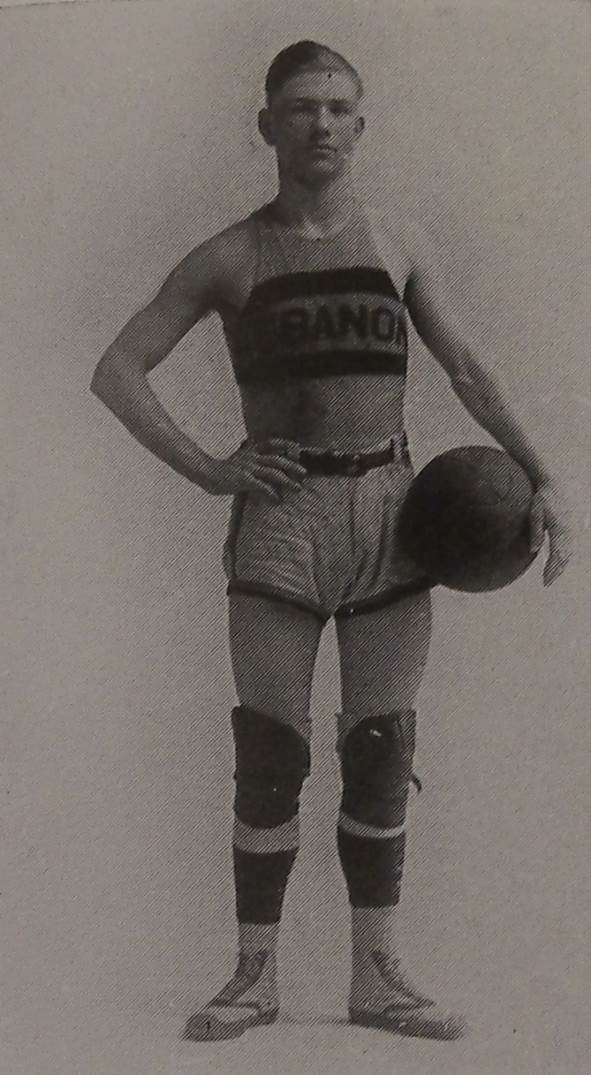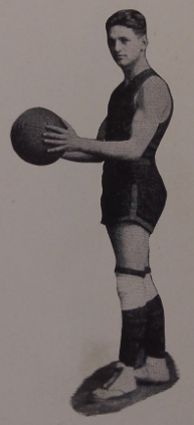In 1917, basketball was only twenty-five years old. Indiana high school basketball was a bit younger than that, and the state tournament was only in its seventh year (its sixth under Indiana High School Athletic Association control). Hoosier Hysteria was quickly taking root, as year after year more high school teams entered sectional tournaments with dreams of hardwood glory. Basketball in Lebanon began a bit later than other communities, but it quickly became a favorite sport of the town’s teenage boys. The school team’s reputation and skill-level improved year after year and culminated in a state title in 1912. Many influential figures in basketball’s development in the state walked the halls of Lebanon High School in the 1910s. The following narrative provides an overview of some of those people, and their accomplishments that culminated in Lebanon winning a second state basketball title in 1917.
Lebanon High School’s coach Ward “Piggy” Lambert was among the best Indiana high school coaches in the nineteen-teens. He came to Lebanon after their first state championship, and started coaching in the fall of 1912. He won 79% of his games in four seasons on the bench. His teams were perennial title contenders. Perhaps the best team that he coached at Lebanon was the 1914 squad, which due to an unfortunate draw in the state tournament played six games in a little over twenty-four hours before succumbing to fatigue and the well-rested, Homer Stonebraker-led, Wingate team, which won the 1914 crown. In 1915, Thorntown’s team surprised Coach Lambert’s squad in the sectional, and went on to win the 1915 title. Lambert and his boys reclaimed the sectional in 1916, but suffered a narrow, and disappointing defeat to Martinsville in the second round of the state tournament.

Lebanon projected to return most of its team the following season, including two impressive underclassmen who were first and third on the team in scoring. Unfortunately, Coach Lambert would not return for a fifth season. In the summer of 1916, he became the head basketball coach at Purdue University where he would go on to a hall-of-fame career, and positively influence generations of players, including John Wooden. Lebanon’s high school administrators hired Wabash College graduate Alva R. Staggs to replace Lambert, and teach English. However, Lambert’s coaching in the years before had honed athletic skills, developed high basketball IQs, and created a winning culture in his high school charges, and set the stage for Staggs’ successful season.
THE REGULAR SEASON
Due to injuries and eligibility issues, the 1916-17 Lebanon squad did not start the season as anticipated. Three year letterman and team captain Frank “Doc” Little, who played back guard, would miss most of his senior season due to a hip injury. Gerald Gardner, who the Indianapolis News described as “evasive as a mosquito,” had been a third team all-tournament player in ’16 after accounting for 42% of Lebanon’s points. Yet, academic eligibility issues erased most of the forward’s junior season.

Even with these personnel losses, the Lebanon coach and players adapted. Staggs cycled through six different starting line-ups in the first ten games of the season. The two constants in the line-up were floor guard Don White and back guard Clyde Grater. White, a junior, was the team’s leading scorer as a sophomore and would retain the honor for the rest of his high school career. Grater, a sophomore, was in his first year on the varsity. At 5’ 8½” in height, he was much shorter than the prototypical back guard who was at this time the tallest and heaviest player on the team. Despite his average stature, Grater played the defensively-obsessed role very well. Other players who started for Lebanon in the early part of the season were George White (Don’s older brother), Charles “Dutch” Frank, Bob Ball, Harry “Peck” DeVol (the Whites’ first cousin), and Fred “Cat” Adam (the second-leading scorer from the previous season).
Lebanon rolled through the first half of the season. They compiled an 9-0 record against Veedersburg, Advance, Rockville, Washington, New Richmond (twice), Thorntown, Lafayette Jefferson, and Martinsville. The squad averaged ten points better than their opponents during this span. The game against defending state champ Lafayette Jeff was such an anticipated early season event that a Jeff physics teacher sent in-game updates via wireless to an amateur radio operator in Lebanon. The Lebanon receiver subsequently relayed updates of the game to local businesses via telephone.

After the triumph over Jeff, a few cracks appeared in the quality of the team’s play. A revenge-hungry New Richmond team played a physically rough game in which Lebanon escaped with a five point lead. In the next game, Lebanon had to go into overtime to defeat Martinsville by a last second field goal. They returned home to play Advance, and the wheels fell off. The up-start Boone County rival shellacked Lebanon, 28-6. A week later Lebanon lost to another Boone County team in Thorntown, 30-20.
Although on a two-game losing streak, the “Black and Gold” had a 9-2 record and a favorable schedule ahead against Frankfort (twice), Crawfordsville (twice), an away game against Rochester, and home games against Jeff, Washington, Martinsville, and Bedford. Over the final ten games, Coach Staggs settled on a regular line-up of DeVol and Adam at forwards, Ball at center, and White and Grater in the back court. With this line-up, Staggs fielded a trio of his best scorers. White was the team’s most consistent scorer all season with ten points per game. Ball and Adam disappointed over the first ten games with averages of less than three points. However, once inserted into the starting line-up the duo averaged ten points a piece over the final 10 games. With five games left in the season, “Doc” Little and Gerald Gardner returned to the team. Their immediate contributions were minimal, but they bolstered the bench of a booming Lebanon team. Over the final nine games, the Lebanon cagers routed their opponents by over 26 points a game. On the season, the team compiled an 18-2 record, with an offensive average of 33.15 points a game, and a defensive average of 17.9 points against.
THE SECTIONAL TOURNEY

The Indiana High School Athletic Association selected Lebanon as a district host for a sectional tournament, which was held on March 9 and 10, 1917. The townsfolk welcomed squads and fans from Boone, Carroll, and Clinton counties, including: Advance, Bringhurst, Burlington, Colfax, Cutler, Delphi, Flora, Frankfort, Jamestown, Kirklin, Thorntown, and Zionsville. Don White and company had little trouble with their first two sectional opponents, Cutler and Delphi, and defeated the Carroll County teams by an average margin of victory of 59 points.
Their next challenger, Thorntown, would present a much tougher match-up. The friendly rivals had split their regular season series. Thorntown also had the advantage of having three players and a coach from their championship season in 1915. The scores were close throughout the sectional game. Thorntown held a 10-9 lead at intermission. This was only the third time all season that Lebanon trailed at half time, and they lost on the previous two occasions. Don White determined to not let it happen again. He came out white hot in the second half with seven unanswered points. His scoring whipped the fans into a frenzy. Thorntown was down seven with a quarter to play. They clawed back, and cut Lebanon’s lead to three, but a series of miscues including two missed free throws sealed the fate of the Sugar Creek Township team.
Prognosticators picked the sectional final between Lebanon and Advance to be another tough contest, especially after Advance’s surprise victory over Lebanon at mid-season. However, Advance lost their star player to injury in the semi-final. To compound matters for Advance, Lebanon’s bench depth allowed Coach Staggs to flex his line-up to rest his regular starters and give “Doc” Little and Gardner some additional playing time. In the final, White’s 17 points almost outscored Advance single-handedly as Lebanon powered past Advance, 37-18.
THE STATE FINALS
On March 16, twenty sectional winners convened at Indiana University to vie for the state title. Lebanon played three uncompetitive contests in the early rounds to advance to the finals. They sank Trafalgar in their first contest, 34-14. In the quarterfinals, the Lebanonites left Kendallville tilting at windmills, 43-8. In the semis, the Boone County boys sent Martinsville packing, 36-12.
The final pitted Lebanon against the speedy Gary Emerson team. The majority of the crowd of 4,000 rallied behind the underdogs from Gary at the start. Yet the crowd grew silent as Lebanon built a 25-15 lead by half time. The Steel City team went on a run in the second half to make it a three point game. With the score at 25-22, Lebanon surged ahead with a 9-4 run to ice the game, 34-26. White and Adam tied for team highs with ten points a piece.
With the win, Lebanon won its second state championship. White was a consensus all-state tournament first team member. Adam, Little, and DeVol appeared on various all-tournament lists either on the first or second teams.

POSTSCRIPT
Coach Staggs left Lebanon after the school year to accept a job at Anderson High School. Little, DeVol, and Frank would join mid-season graduate George White in the ranks of Lebanon alumni. Bob Ball although technically a junior would leave high school and enter DePauw University, depriving the team of its second leading scorer. Yet the core of White, Grater, and Adam would return for the 1917-18 season. Under the tutelage of a new coach, Glenn Curtis, and a younger cast of supporting characters they would win the state tournament again, and join the historical annals with Wingate as back-to-back state champions.
After graduating in 1918, Don White reunited with his old coach, Ward Lambert, and continued his athletic career at Purdue. He was second in the Big Ten in scoring as a sophomore, and led the conference in scoring as a junior while also leading the university to the conference title in 1921. After college, White entered the coaching ranks where he had a thirty-five year career at Washington University (St. Louis), the University of Connecticut, and Rutgers. He even coached Thailand’s Olympic team in 1956.
After high school, Adam and Grater teamed together again at Wabash College where they were multi-sport athletes, and fixtures in the basketball line-up. After graduation they both became high school teachers and coaches.
Learn more about Lebanon High School basketball history with a presentation by IHB Director Chandler Lighty at the Lebanon Public Library. The talk takes place Monday, March 20, 2017 from 6-8 p.m. and includes a special viewing of an LHS 1967 basketball film.
